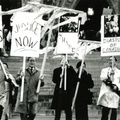Japanese American Nisei, born in the incarceration camps have launched the Tsuru (origami cranes) campaign and have been demonstrating at US detention centres where immigrant children are currently being held. A march of Japanese Americans on the White House is planned for June 5-7, 2020. The organizers’ aim is to circle the White House fence with tsuru as a sign of “peace and solidarity.” It will be the largest demonstration ever of Japanese Americans, led by 100 taiko drummers. Japanese Canadians will be joining the march. If you are interested in the American Tsuru campaign, you can check out their website: www.tsuruforsolidarity.org to view their videos and for more information.
In a powerful video that documents a confrontation between Japanese American tsuru protestors and US military police, the Nisei are told that they must leave the American army prison camp site. The Nisei demonstrators reply: “Unless you are going to arrest us, we will not move.” Inside, behind the barbed wire fence, were immigrant children, separated from their parents. The Japanese Americans wore placards that said, “I was a child inmate in an American prison camp.” Japanese Americans have launched the tsuru drive to protest Trump’s policy of locking up refugees and undocumented immigrants. 2019 is not the first time that Japanese American Nisei and Sansei have campaigned against U.S. Legislation permitting a repeat of the WWII Japanese American experience.
These present-day demonstrations should be seen against a background of campaigns by Japanese Americans against legislation that could be used to incarcerate dissent groups into prison camps. Professor Izumi’s book on American Concentration Camp Law documents the first struggle of Japanese Americans to protest against the detention of civilians in American concentration camps. Izumi examines the period from 1942 to 1971, that is, from the Japanese American Internment to the Civil Rights Movement years. The US, unlike Canada (that had the War Measure Act), did not have any emergency legislation when war was declared. Instead, after the Japanese Imperial Army’s bombing of Pearl Harbor in December 1941, President Roosevelt signed Executive Order 9066 that turned over to the Secretary of War, Henry Stimson and General DeWitt complete authority over Japanese Americans. Then Congress passed Public Law 503 that made violating military orders a misdemeanor.
Protesting what they felt was a breach of their Constitutional rights, three Nisei—Min Yasui, a lawyer; Gordon Hirabayashi, a student; and Fred Korematsu, a welder—violated the military incarceration and relocation orders and were imprisoned. Their convictions were reviewed by the US Supreme Court and on June 21, 1943, the Court upheld their removals and detentions and that of all Japanese Americans. This was in stark contrast to the treatment afforded German Americans. In the 1943 Schueller v. Drum decision, the Federal Court judges unanimously ruled that Exec. Order 9066 and Public Law 503 against German Americans were invalid.
Surprisingly, a year later on December 18, 1944, the US Supreme Court decided in favour of 21-year-old secretary Mitsuye Endo’s petition to be released from camp. The day after this decision, the exclusion orders were lifted against “loyal” Japanese Americans, who were allowed to return to their homes. Japanese born in the US had the rights and protections of citizenship and the American Constitution. Japanese Canadians did not gain these rights until April 1, 1949.
The main focus of Izumi’s book is the Emergency Detention Act (EDA), which was passed in 1950, at the height of McCarthyism and the Communist Red Scare, post WWII. The Act authorized mass detentions and removals on the grounds of national security but specifically excluded mass detentions based on race. A decade later, during the activism of the 1960s, concern was raised by Black Panthers, Native Americans, and civil rights activists about EDA’s preventive detention powers, which required the constant surveillance of citizens.
At the same time, some in the Japanese American community saw parallels to the possibility of mass incarcerations under the EDA. In 1967, Japanese American Nisei led by Raymond Okamura, Edison Uno, and Paul Yamamoto convinced the more conservative Japanese American Citizens’ League (JACL) to spear head a coalition against American concentration camps. The JACL, American Civil Liberties Association, Japanese American Hawaiian Senator Daniel Inouye, and Congressman Spark Matsunaga (among others) worked to introduce a JACL sponsored Bill for the Repeal of the EDA. This four-year campaign led by Japanese Americans was successful. On September 25, 1971, President Nixon signed the bill repealing the EDA.
Izumi’s book invites comparisons between the different treatment that Japanese Canadians and Japanese Americans received at the hands of their racist Governments. The American experience differs from the Canadian in several respects. For example, Canada enacted the War Measures Act (WMA) in 1914, after WWI was declared. The broad powers of the WMA enabled Cabinet alone to legally remove, incarcerate, and confiscate Japanese Canadian property. The Americans had no such Emergency legislation until 1950.
In the late 1970s the NAJC had a War Measures Act committee, headed up by Hamilton urologist Dr. Art Shimizu (lawyers Shin Imai and I were members of the Committee working to repeal the Act.) In 1988, Parliament had public hearings on the repeal of the WMA. Roy Miki and Ann Sunahara appeared before the Committee for the NAJC. In 1988, the WMA was repealed but replaced with the Emergencies Act (EA). This law is very similar to the American Emergency Detention Act of 1950 that the JACL had successfully gotten repealed in 1971. Under the new Canadian Emergencies Act, individuals can seek compensation, Parliament, not just Cabinet, must approve laws passed pursuant to the EA and all laws are subject to the Charter of Rights and Freedoms.
Further comparisons: Izumi writes that the estimated American cost of removal and incarceration was $1/4 Billion US. Contrast this to the Canadian situation, where Japanese Canadians paid for their incarceration and removal through the forced sale of their property. Following the end of the war, pursuant to the Japanese Evacuation Claims Act, “for damages to or loss of real or personal property,” 23,689 claims were filed and the US Government paid out $38M, less than 10 cents for every dollar lost. This is similar to the Bird Commission’s low balling of Japanese Canadian losses. Izumi reports that “the wartime removal and incarceration of Japanese Americans has become one of the most heavily studied civil rights violations in US history.” By contrast, the trampling of Japanese Canadian rights has been largely ignored by Canadian academics.
Following the successful repeal of the EDA in 1971 by Japanese Americans, the US did not have Emergency legislation for 30 years. However, this all changed post Sept. 11, 2001, when suicide bombers attacked the World Trade Centre in NYC. Five days, later, on September 16, 2001, Congress passed the USA Patriot Act permitting the incarceration of “enemy combatants” and the creation of the Department of Homeland Security.
THE RISE & FALL OF AMERICA’S CONCENTRATION CAMP LAW
By Masumi Izumi
(Philadelphia, PA: Temple University Press, 2019, 274 pp., Hardcover)
Professor Masumi Izumi is a political scientist teaching in Kyoto.
* This article was originally published on The Bulletin: A Journal of Japanese Canadian Community, History + Culture on January 21, 2020.
© 2020 Maryka Omatsu






